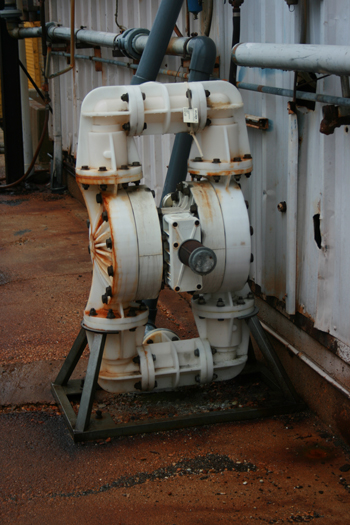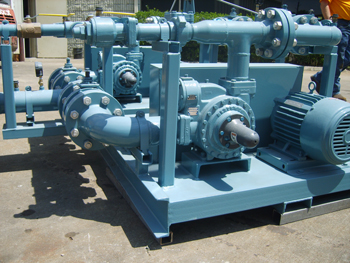Many factors must be considered before choosing the proper pump for a specific application.
Editor's Note: This is the first in a two-part series. For the second and last part in this series, click here.
The Challenge
A baseball player doesn't stride to the plate to face a fireballing right-hander armed with a fly swatter. A professor of nuclear physics doesn't use Fun with Dick and Jane as a textbook. And you wouldn't unload a railcar filled with thousands of gallons of vegetable oil with a straw.
In other words, it is hard to do the job correctly if you are not equipped with the proper tools. In the first two examples, the solution is easy—bring a bat to the plate and provide your students with a textbook that covers the basics of nuclear physics. When we consider the third example, the list of possible solutions grows exponentially before choosing the correct pump for the application. Variables such as those listed below must be quantified before a decision can be made:
• Flow rate and required pressure and how they help determine the proper pump size
• The desired operating efficiency and total life cycle costs
• Product temperature and viscosity
• Suction lift requirements
• The corrosive and erosive properties of the product and the material compatibility of the pumping equipment to those properties
• The best way to ensure product containment and eliminate cross-contamination
• How the pump will be driven and at what speed
Incorporating all these considerations into your pump selection process can seem daunting. Many technologies are available from which to choose. However, one basic technology can maximize operating performance across a wide range of applications—positive displacement (PD) pump technology. Basically, PD pumps cause a fluid to move by trapping a fixed amount of the fluid and then forcing that trapped volume into a discharge pipe. Due to this design and operation, PD pumps generally have more flexibility when dealing with the varying changes in pressure and flow requirements found in continuous or intermittent-type processes. PD pumps also maintain higher efficiencies across changing operating conditions, including viscosity changes, which can lead to improved energy efficiency.
With all that said, this article will focus on a specific list of PD pumping technologies—air operated diaphragm, sliding vane and metering in Part One and peristaltic (hose) and eccentric disc in Part Two.
Air-Operated Double-Diaphragm Pumps
Positive-displacement double-diaphragm pump technology was invented in 1955 as the solution for demanding utilitarian applications that need a robust pump design—from chemical and ceramic production to mining and waste-treatment applications. Diaphragm pumps satisfy the demands of these industries because their design allows the product flow to remain constant with the speed of the pump. The pumps can be constructed with a multitude of elastomer options, including Teflon® PTFE, to meet most material-compatibility concerns.
 |
AODD pump |
An air-operated double-diaphragm (AODD) pump operates by displacing fluid from one of its two liquid chambers upon each stroke completion. With the AODD pump design, only a few wetted parts are dynamic: the two diaphragms, which are connected by a common shaft; the two inlet valve balls and the two outlet valve balls. The diaphragms act as a separation membrane between the compressed air supply and the liquid. Driving the diaphragms with compressed air instead of the shaft balances the load on the diaphragm, which removes mechanical stress from the operation and extends diaphragm life.
The major benefits of AODD pumps include their ability to be used in a wide range of pressure and flow specifications, self-priming and low-wear operation, ability to handle corrosive and abrasive solutions, consistent performance and lower operational costs.
Sliding Vane Pumps
For more than a century, PD sliding vane pump technology has been the number one choice for a wide variety of pumping applications. The list of applications where the use of vane technology sets the standard is virtually endless—the transfer of petroleum fuels and lubes, handling of refrigeration coolants (such as Freon and ammonia), bulk transfer of LPG and NH3, LPG cylinder filling, the transfer of aerosols and propellants and the transfer of solvents and alcohols are among the most popular.
Sliding vane pumps are ideal for these applications because they offer high energy efficiency and low maintenance when compared to other traditionally used pumps, including gear pumps. These are important factors in today's environment of rising costs, lean personnel staffs and high demand for increased profitability. The secret to the success of vane-pump technology to satisfy these crucial considerations are the vanes that slide into and out of slots in the pump's rotor. The pump's rotation draws liquid in behind each vane and as the rotor turns, the liquid is transferred between the vanes to the outlet where it is discharged. This results in continuous, optimal pump performance because each revolution of the pump rotor displaces a constant amount of fluid, while variances in pressure have a negligible effect. This means that energy-wasting turbulence and slippage in the pump are minimized and high volumetric efficiency is maintained.

Sliding vane pumps
Recent advancements in vane pump technology have increased a pump's operational efficiency and longevity even more, including the development of cavitation/noise-suppression liners that control the wear effects of cavitation and reduce noise levels by up to 15 decibels. Motor-speed sliding vane pumps have been engineered for continuous-duty operation. Many sliding vane pumps can be serviced inline without removing the suction and discharge piping.
Sliding vane pump technology has many advantages:
• The ability to handle thin liquids at high pressures
• Dry-run capabilities
• Wear compensation through vane extension
• Good vacuum pressure
Metering Pumps
Simply defined, metering pumps are used to inject liquids at precisely controlled, adjustable flow rates—a process that is often called metering. Controlled-volume metering pumps are reciprocating PD pumps that can be used to inject chemical additives, proportional blending of multiple components or metered transfer of a single liquid. Their design characteristics make these types of pumps desirable for applications that require highly accurate, repeatable and adjustable rates of flow.
Therefore, metering pumps are most often used to pump chemical solutions and expensive additives that are used in products manufactured in a wide variety of industries, including industrial, medical, chemical, food and dairy, pharmaceutical and biotech, environmental, fuel cell and laboratory. Metering pumps have been designed to pump into low- or high-discharge pressures at controlled flow rates that are constant when averaged over time. In terms of construction, most metering pumps consist of a pump head—through which the substance being pumped enters an inlet line and exits through an outlet line—and an electric motor, the most commonly used driver.
In next month's “Efficiency Matters,” more PD pumping technology will be discussed including eccentric disc and peristaltic pumps as well as how the proper pumping technology can increase efficiency.
Pumps & Systems, January 2011
Tom Stone is the director of marketing for Blackmer®, based in Grand Rapids, Mich., an operating company within Dover Corporation's Pump Solutions Group (PSG™), Downers Grove, Ill. PSG is comprised of six leading pump companies—Wilden®, Blackmer, Griswold™, Neptune™, Almatec® and Mouvex®.

